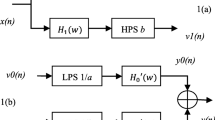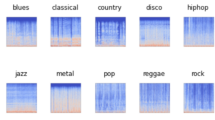Abstract
When it comes to offering song suggestions to a user, the music genre is one of the most used tags considered by music streaming services. Motivated by the growing number of songs available, automatic music genre classification systems have become a valuable tool for the creation of user-personalised playlists. Considering that feature engineering represents a major task to be addressed when one develops such systems, this work discusses the generation of new handcrafted features over songs, originally exploring high-order features’ moments combined with their derivatives. Additionally, this paper proposes a new wrapper-based selection procedure rigorously based on statistical tests to identify a subset of features that maximise the performance of these systems, irrespective of the classification approach adopted, named Robust Selector of Basis Feature Sets. Based on a synergistic combination of both strategies, a compact subset with 81 features is derived over the GTZAN Dataset. When compared with alternative solutions, this feature set boosted the classification accuracy in datasets containing a wide range of music genres, such as ISMIR2004, BALLROOM, HOMBURG, and FMA Datasets.














Similar content being viewed by others
Data availability
The datasets analysed are publicly available, as well the materials used in the implementation.
Code availability
The code can be requested from the authors.
Notes
References
Li S, Karatzoglou A, Gentile C (2016) Collaborative filtering Bandits. In: Proceedings of the 39th international ACM SIGIR conference on research and development in information retrieval. SIGIR ’16, pp 539–548
Tzanetakis G, Cook P (2002) Musical genre classification of audio signals. IEEE Trans Speech Audio Process 10(5):293–302. https://doi.org/10.1109/TSA.2002.800560
Markov K, Matsui T (2014) Music genre and emotion recognition using Gaussian processes. IEEE Access 2:688–697. https://doi.org/10.1109/ACCESS.2014.2333095
Baniya BK, Lee J (2016) Importance of audio feature reduction in automatic music genre classification. Multimedia Tools Appl 75(6):3013–3026. https://doi.org/10.1007/s11042-014-2418-z
Foleis JH, Tavares TF (2020) Texture selection for automatic music genre classification. Appl Soft Comput 89:106127. https://doi.org/10.1016/j.asoc.2020.106127
Singh Y, Biswas A (2022) Robustness of musical features on deep learning models for music genre classification. Expert Syst Appl 199:116879. https://doi.org/10.1016/j.eswa.2022.116879
Medhat F, Chesmore D, Robinson J (2020) Masked conditional neural networks for sound classification. Appl Soft Comput 90:106073. https://doi.org/10.1016/j.asoc.2020.106073
Ashraf M, Geng G, Wang X, Ahmad F, Abid F (2020) A globally regularized joint neural architecture for music classification. IEEE Access 8:220980–220989. https://doi.org/10.1109/ACCESS.2020.3043142
Yi Y, Chen KY, Gu HY (2019) Mixture of CNN experts from multiple acoustic feature domain for music genre classification. In: 2019 Asia-Pacific signal and information processing association annual summit and conference (APSIPA ASC), pp 1250–1255
Kim J, Urbano J, Liem CCS, Hanjalic A (2020) One deep music representation to rule them all? A comparative analysis of different representation learning strategies. Neural Comput Appl 32(4):1067–1093. https://doi.org/10.1007/s00521-019-04076-1
Sousa JM, Pereira ET, Veloso LR (2016) A robust music genre classification approach for global and regional music datasets evaluation. In: 2016 IEEE international conference on digital signal processing (DSP), pp 109–113
Kobayashi T, Kubota A, Suzuki Y (2018) Audio feature extraction based on sub-band signal correlations for music genre classification. In: 2018 IEEE international symposium on multimedia (ISM), pp 180–181
Carbonneau MA, Cheplygina V, Granger E, Gagnon G (2018) Multiple instance learning: a survey of problem characteristics and applications. Pattern Recogn 77:329–353. https://doi.org/10.1016/j.patcog.2017.10.009
Muniz VHS, Souza Filho JBO (2021) Feature vector design for music genre classification. In: 2021 IEEE Latin American conference on computational intelligence (LA-CCI), pp 1–6
Silla Jr CN, Koerich AL, Kaestner CAA (2008) Feature selection in automatic music genre classification. In: 2008 Tenth IEEE international symposium on multimedia, pp 39–44
Serwach M, Stasiak B (2016) GA-based parameterization and feature selection for automatic music genre recognition. In: 2016 17th international conference computational problems of electrical engineering (CPEE), pp 1–5
Pons J, Lidy T, Serra X (2016) Experimenting with musically motivated convolutional neural networks. In: 2016 14th international workshop on content-based multimedia indexing (CBMI), pp 1–6
Liu C, Feng L, Liu G, Wang H, Liu S (2021) Bottom-up broadcast neural network for music genre classification. Multimedia Tools Appl 80(5):7313–7331. https://doi.org/10.1007/s11042-020-09643-6
Raissi T, Tibo A, Bientinesi P (2018) Extended pipeline for content-based feature engineering in music genre recognition. In: 2018 IEEE international conference on acoustics, speech and signal processing (ICASSP), pp 2661–2665
Seo JS, Lee S (2011) Higher-order moments for musical genre classification. Signal Process 91(8):2154–2157. https://doi.org/10.1016/j.sigpro.2011.03.019
Wu M, Wang Y (2015) A feature selection algorithm of music genre classification based on ReliefF and SFS. In: 2015 IEEE/ACIS 14th international conference on computer and information science (ICIS), pp 539–544
Chae J, Cho SH, Park J, Kim DW, Lee J (2021) Toward a fair evaluation and analysis of feature selection for music tag classification. IEEE Access 9:147717–147731. https://doi.org/10.1109/ACCESS.2021.3123966
Wald R, Khoshgoftaar T, Napolitano A (2013) Comparison of stability for different families of filter-based and wrapper-based feature selection. In: 2013 12th international conference on machine learning and applications, vol 2, pp 457–464
Saeys Y, Abeel T, Van de Peer Y (2008) Robust feature selection using ensemble feature selection techniques. In: Proceedings of the European conference on machine learning and knowledge discovery in databases. Part II, vol 5212, pp 313–325
Laranjeiro N, Agnelo J, Bernardino J (2021) A systematic review on software robustness assessment. ACM Comput Surv. https://doi.org/10.1145/3448977
Zhang WJ, Lin Y (2010) On the principle of design of resilient systems—application to enterprise information systems. Enterprise Inf Syst 4(2):99–110. https://doi.org/10.1080/17517571003763380
Bez CL, Souza Filho JBO, de Vasconcelos LGLBM, Frensch T, da Silva EAB, Netto SL (2021) Multimodal soccer highlight identification using a sparse subset of frames integrating long-term sliding windows. Inf Sci 578:702–724. https://doi.org/10.1016/j.ins.2021.07.066
Brase CH, Brase CP (2016) Understanding basic statistics, enhanced. Cengage Learning, Boston
Krishnan S, Magimai-Doss M, Seelamantula CS (2013) A Savitzky-Golay filtering perspective of dynamic feature computation. Signal Process Lett IEEE 20:281–284. https://doi.org/10.1109/LSP.2013.2244593
Su X, Liu F (2018) A survey for study of feature selection based on mutual information. In: 2018 9th workshop on hyperspectral image and signal processing: evolution in remote sensing (WHISPERS), pp 1–4
Shi X, Xing F, Guo Z, Su H, Liu F, Yang L (2019) Structured orthogonal matching pursuit for feature selection. Neurocomputing 349:164–172. https://doi.org/10.1016/j.neucom.2018.12.030
Visalakshi S, Radha V (2014) A literature review of feature selection techniques and applications: review of feature selection in data mining. In: 2014 IEEE international conference on computational intelligence and computing research, pp 1–6
You SD, Hung MJ (2020) Reducing dimensionality of spectro-temporal data by independent component analysis. In: 2020 2nd international conference on computer communication and the internet (ICCCI), pp 93–97
Grandini M, Bagli E, Visani G. Metrics for multi-class classification: an overview. Available from: arXiv:2008.05756
Japkowicz N, Shah M (2011) Evaluating learning algorithms: a classification perspective. Cambridge University Press, Cambridge
Demšar J (2006) Statistical comparisons of classifiers over multiple data sets. J Mach Learn Res 7:1–30
Wolpert DH (1996) The lack of a priori distinctions between learning algorithms. Neural Comput 8(7):1341–1390. https://doi.org/10.1162/neco.1996.8.7.1341
Abu-Mostafa YS, Magdon-Ismail M, Lin HT (2012) Learning from data. AMLBook
Murphy KP (2022) Probabilistic machine learning: an introduction. MIT Press, Cambridge
Mittelhammer R, Judge G, Miller D (2000) Econometric foundation. Cambridge University Press, Cambridge
Modi S, Lin Y, Cheng L, Yang G, Liu L, Zhang WJ (2011) A socially inspired framework for human state inference using expert opinion integration. IEEE/ASME Trans Mechatron 16(5):874–878. https://doi.org/10.1109/TMECH.2011.2161094
Cano P, Gómez E, Gouyon F, Herrera P, Koppenberger M, Ong B, ISMIR, et al (2004) audio description contest. Tech Rep MTG-TR-2006-02. Universitat Pompeu Fabra 2006, pp 1–20
Homburg H, Mierswa I, Möller B, Morik K, Wurst M (2005) A benchmark dataset for audio classification and clustering. In: Proc. 6th Int. Conf. Music Information Retrieval, pp 528–531
Defferrard M, Benzi K, Vandergheynst P, Bresson X (2017) FMA: a dataset for music analysis. In: 18th International society for music information retrieval conference (ISMIR). Available from: arXiv:1612.01840
Bhat AD, Acharya HR, HRS (2019) A novel solution to the curse of dimensionality in using KNNs for image classification. In: 2019 2nd international conference on intelligent autonomous systems (ICoIAS), pp 32–36
Ng WWY, Zeng W, Wang T (2020) Multi-level local feature coding fusion for music genre recognition. IEEE Access 8:152713–152727. https://doi.org/10.1109/ACCESS.2020.3017661
Funding
This study was financed in part by the Coordenação de Aperfeiçoamento de Pessoal de Nível Superior - Brasil (CAPES) Finance Code 001, CNPq, and FAPERJ.
Author information
Authors and Affiliations
Contributions
The authors equally contributed to this work.
Corresponding author
Ethics declarations
Competing interests
The authors have no competing interests to declare that are relevant to the content of this article.
Additional information
Publisher's Note
Springer Nature remains neutral with regard to jurisdictional claims in published maps and institutional affiliations.
Supplementary Information
Below is the link to the electronic supplementary material.
Rights and permissions
Springer Nature or its licensor (e.g. a society or other partner) holds exclusive rights to this article under a publishing agreement with the author(s) or other rightsholder(s); author self-archiving of the accepted manuscript version of this article is solely governed by the terms of such publishing agreement and applicable law.
About this article
Cite this article
da Silva Muniz, V.H., de Oliveira e Souza Filho, J.B. Robust handcrafted features for music genre classification. Neural Comput & Applic 35, 9335–9348 (2023). https://doi.org/10.1007/s00521-022-08069-5
Received:
Accepted:
Published:
Issue Date:
DOI: https://doi.org/10.1007/s00521-022-08069-5




